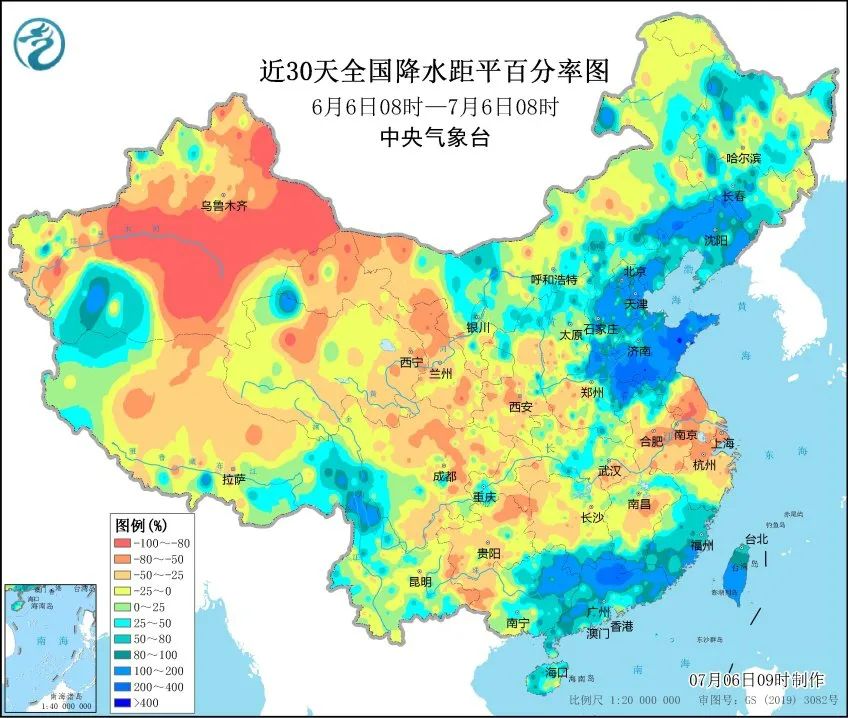The rainfall in the north is frequent in the near future, and the rainy season comes early?| Expert interpretation
Author:China Meteorological Administr Time:2022.07.08

The public in northern my country
There may be such feelings recently
How does the rain every day?
Since June
Beijing -Tianjin -Hebei, Middle East Inner Mongolia, Shandong
The rainfall in Liaoning and Jilin is obviously too much

From July 6th to 7th, Yingkou, Liaoning, settled heavy rain, and some low -lying roads appeared. Picture/Wen Wu Yumeng
The rainy season of North China and Northeast, which was originally "seven or eight"
Is it early?
How much is the recent rainfall in the north?
what is the reason?
Will there be more rain in the north in the future?
This
Zhang Bo, a senior engineer of the Central Meteorological Observatory
Yuan Yuan, a researcher at the National Climate Center Climate Forecast Office
Yang Chengfang, the director of the Shandong Meteorological Observatory
Yan Qi, chief of the Liaoning Meteorological Observatory
Bring an interpretation
Intersection
Core reading
Since June, there have been obvious rainfall in the north, and the reason is closely related to the subtropical high pressure position.
The rainy season in North China is currently considered to be early as possible
The rainfall of North China this year is expected to be too much, and the effect of special prevention of rainfall is needed
01
The rainfall in the north is too much, which is closely related to the subtropical high pressure position.
Meteorological monitoring shows that since June 1, Beijing -Tianjin -Hebei, the central and eastern of Inner Mongolia, Shandong, Liaoning, and southern Jilin have significantly more than twice the local area.
According to statistics, a total of 5 precipitation process occurred from June 1st to July 4th from Hebei Province. The average precipitation of the province was 134.9 mm, which was 69.3%more than the same period of the year. The average precipitation of the province in Liaoning was 173.4 mm in June, 91.6%more than the same period of the year, and the same period since 1951. The average precipitation of Shandong Province from June 1st to July 5th was 213.2 mm, which was 118%more than usual.

During this period, rainfall should not be so much in the northern region. Every year, the movement of the rain belt in my country and the high pressure of the Western Pacific subtropical (hereinafter referred to as the "West Taitai High"), the high pressure south pressure, the subtropical west wind rapid flow, and the seasonal changes of the East Asian monsoon: April to May, the flood season in South China; June From the middle and late July, it is the rainy period of Jianghuai; from mid -to -late July to August, it is the rainy season in North China and Northeast China; from September to October, it is the rainstorm during the West China. According to the laws of previous years, the moment is still in the time of Jianghuai.
Zhang Bo, a senior engineer of the Central Meteorological Observatory, introduced that since late June, the rainfall in the north is significantly too much, which is closely related to the position of Western Pacific high. The rainfall in the rainy season in North China mainly appeared on the northwest side of the West Pacific Deputy High. This year, the West Tai Vice Gao North Jump (moving north) was too early, and the location was north, causing the rain belt to move north to the Huanghuai area of North China.
From June 21st to July 5th, the location of the Western Pacific Deputy Height continued to north. Taking June 22 as an example, the position of the ridge line of the Western Deputy Gaoguan section is about 22 degrees north latitude, and this year has been lifted to 24 degrees north latitude; the average position of the previous years around July 1 is 24 degrees north latitude to 25 degrees to 25 degrees. Between 34 degrees north latitude this year. According to the forecast, until mid -July, the position of the Western Pacific Deputy Height was north of the past.
02
Will the rainy season in North China be advanced in advance?
According to the forecast of the Central Meteorological Observatory, until July 15, there are still rainfall in North China, Northeast China, Huanghuai and other places. The cumulative rainfall is 40 mm to 80 mm, and 90 mm to 150 mm in some areas. In the early stage of rainfall, there are still rain in the later period. Does it mean the rainy season when the north has entered the "seven or eight" in the past years.
According to Yuan Yuan, a researcher at the National Climate Center Climate Forecasting Office, the center mentioned in the flood season climate forecast released by the center at the end of March that this year's consideration of the rainy season in North China began earlier than usual (July 18). "The rainy season in North China has industry standards. It mainly considers the location of the Xitai vice -ridge line, the cumulative precipitation of the region and the secondary ratio of the standard stations. Early possibilities are more likely. "
According to statistics from the National Climate Center, from 2000 to 2021, the year of the rainy season in North China was significantly early in the rainy season: 2000 (July 6), 2008 (July 15), 2012 (July 9),, July 9),, July 9) 2013 (July 9), 2018 (July 9) and 2021 (July 12).
Zhang Bo introduced that the rainfall in the rainy season in North China is different from the Jianghuai Meimei. The main feature is that the precipitation intensity, strong locality, and uneven distribution of rainfall, defensive strings must be stretched early. "In this case, the forecast and defense difficulty of strong precipitation in the local area are relatively difficult, and they may also appear in advance. It is necessary to make a good effect on research and judgment, early preparations to prevent the adverse effects of urban waterlogging, thunderstorms, and strong counterparts. ","
03
National Climate Center forecast: rainfall or too much in the east and southeast of the Summer Summer this year
The National Climate Center predicts that this year's midsummer, most of Shandong, most of Henan, northern Tianjin, eastern Beijing, eastern Hebei, eastern Liaoning, and southern Jilin are 400 mm to 600 mm. Most of Hebei, central Shanxi, southern and southern, Shandong, Henan and other places are 20 % to 50 %.
Yuan Yuan introduced that under such circumstances, in the area where the heavy rainfall was more rainy in the early stage, it was necessary to specialize in the impact of the stack of rainfall. Especially in the summer, the Yellow River Basin, Haihe Basin, and the Liaohe Basin need to prevent staged heavy precipitation and storms and floods; in the short -term precipitation, thunderstorms, local tornado, hail, etc. in the Northeast, North China and other places. The impact of measures on the production, infrastructure, and personal safety of industrial and agricultural production, infrastructure, and personal safety, and do a good job of prevention of small and medium -sized rivers and urban waterlogging. Yang Chengfang, the director of the Shandong Meteorological Observatory, reminded that special attention should be paid to balanced water storage and flood prevention to prevent floods, floods, geological disasters, and urban and rural waterlogging in small and medium -sized rivers.
Yan Qi, chief of the Liaoning Meteorological Observatory, pointed out that it is necessary to prepare always, strengthen the control and drainage of low -lying road sections in urban urban low -lying roads, dredge the ditch in advance, and prevent the adverse effects of farmland waterlogging and winds caused by heavy rainfall and wind.
Produced by China Meteorological Administration Xuanke Center (China Meteorological News Agency)
Author: China Meteorological Daily All -Media reporter Li Yipeng Correspondent Chen Kezheng Cai Bing Wish Xihang Ma Yan
Expert Consultant: Zhang Bo, a senior engineer of the Central Meteorological Observatory
Yuan Yuan, a researcher at the National Climate Center Climate Forecast Office
Yang Chengfang, the director of the Shandong Meteorological Observatory
Yan Qi, chief of the Liaoning Meteorological Observatory
Edit: Jiang Hong brush Zhang Linhao
Review: Cui Guohui

- END -
What is the difference between grapes, giant peaks, sunlight roses, summer black, and brittle glass?Which is better

No matter which step people go, they have to find some fun and think about it. Yes...
LeTV?optimism!What inspiration of LeTV's reverse marketing to Hunan brand?(Down)

Recently, LeTV has made an official response to the online passing LeTV, and the s...